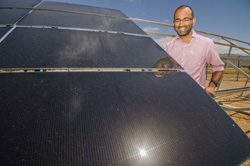 Researchers are trying to figure what motivates which consumers to buy solar equipment. This article from Sandia National Laboratories in California says they’re trying to better understand what persuades people to buy photovoltaic (PV) systems for their homes in hopes of increasing the amount of solar energy in the electricity market from its current share of less than .05 percent to at least 14 percent by 2030.
Researchers are trying to figure what motivates which consumers to buy solar equipment. This article from Sandia National Laboratories in California says they’re trying to better understand what persuades people to buy photovoltaic (PV) systems for their homes in hopes of increasing the amount of solar energy in the electricity market from its current share of less than .05 percent to at least 14 percent by 2030.
“If we can develop effective and accurate predictive models, we can help identify policy variables that could increase purchases of residential PV systems and ultimately help advance the mission of the SunShot Initiative,” said Kiran Lakkaraju, Sandia’s project lead. Specifically, he said, an effective model of solar purchase dynamics can be used to predict and even influence consumer purchasing decisions.
The modeling project, part of the Solar Energy Evolution and Diffusion Studies (SEEDS) program, is one of many activities in the Energy Department’s SunShot Initiative, which seeks to make solar energy cost-competitive with other forms of electricity. SEEDS projects are designed to investigate methods for transforming the operations of solar researchers, manufacturers, developers, installers and policymakers.
Meanwhile, another group of researchers at Sandia are using computer models to predict homeowners’ likelihood to buy and invest in PV systems. A group of 1,000 respondents who have bought PV systems and another 1,000 who have not are being surveyed about their choices with those results being examined by quantitative modeling experts and fed into modeling tools. Other research is looking at how messaging about solar can influence consumer demand.

